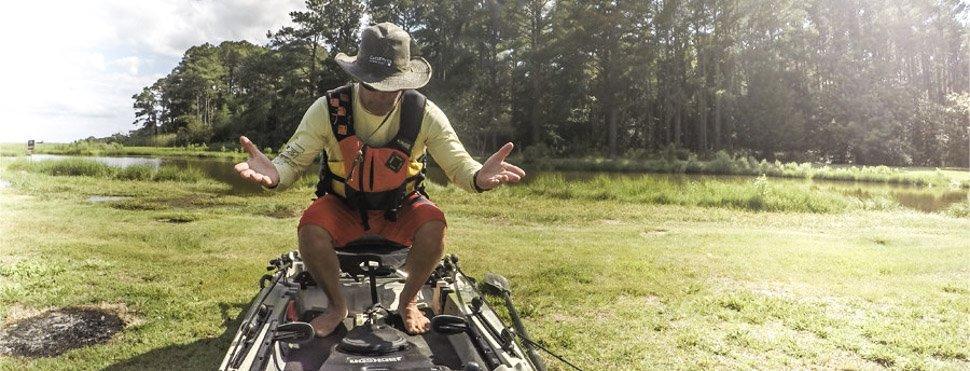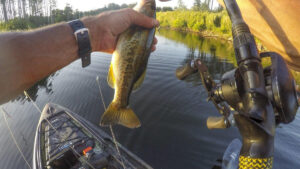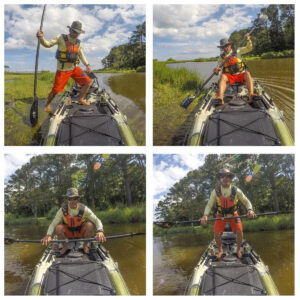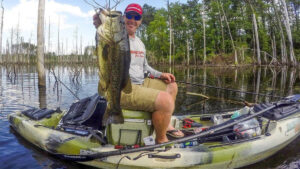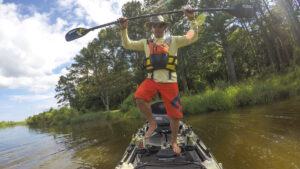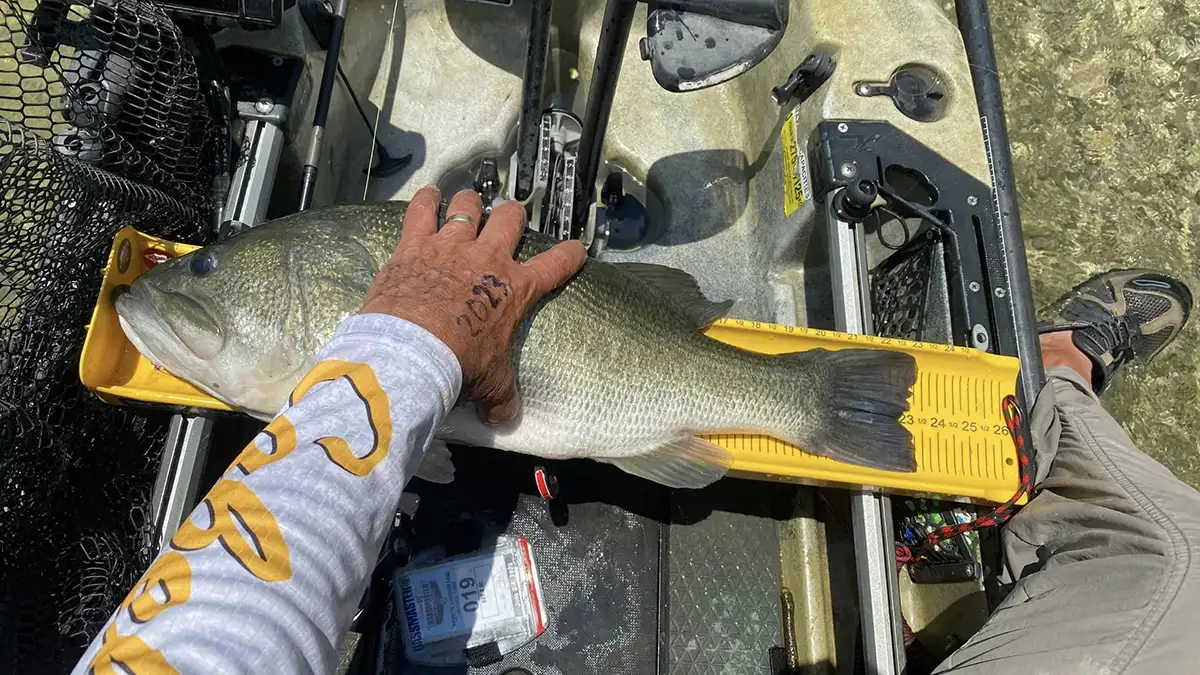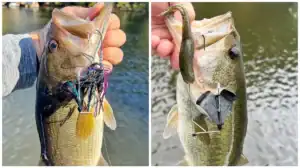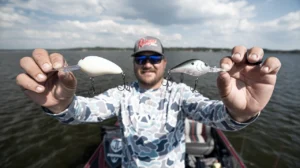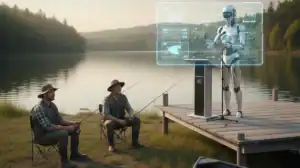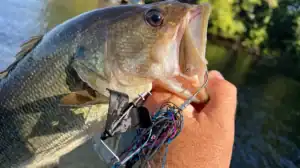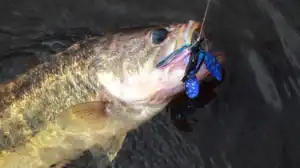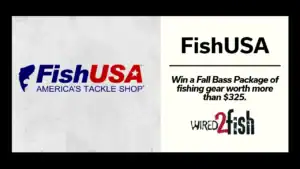If you are reading this article on stand-up fishing from a fishing kayak, the title alone is likely to invoke one of two reactions:
- “I could never stand up in a kayak.”
- “Standing up is easy, so I don’t need to read this.”
The information is in this article should help you catch more fish and enjoy fishing from a kayak even more no matter where you currently “stand on the issue”. We’ll cover the whys, hows, advanced techniques and also what to look out for to keep you dry and in your boat.
THE ADVANTAGES
- Longer and/or more accurate casting.
- Ability to pitch and flip.
- Dramatically increased visibility into the water to see fish and cover.
- Better hook-setting stance.
- Easier to keep fish on the line and out of cover.
This list adds up to more fish each time you go fishing, but only if you are comfortable enough to stand and focus on fishing, not on falling down.
DIFFICULTY DEPENDS
- Stand up fishing depends on your physical condition, flexibility, leg strength and your weight.
- How high your seat is off of the deck of the boat.
- How stable your boat is. While not all are the same, width generally makes it more stable.
- Whether you have a “stand assist strap” or not.
GETTING STARTED: PRACTICE
Dry Land: Your first time trying to stand up in a kayak should be on dry land.
- Sit in the fishing kayak, get your feet as close to the seat as possible, and stand up putting equal pressure on both feet. A stand assist strap can reduce the strain on your legs by 30 percent.
- Sit back down by squatting as low as you can, keeping equal pressure on both feet, and then dropping your rear end square into the seat. Don’t put one hand down on the seat for support while holding a rod in the other. That’s a recipe for falling. Use the stand-assist strap if your legs are not able to support your own weight easily for getting up and down.
- Now stand-up and bend over to grab your rod. Do some casting over the left, right, and behind you to see how your weight shifts while casting. Then put the rod down and sit down again. Once that is comfortable for you, you are ready for the water.
In the Water: Your first time standing with your fishing kayak in the water should be very close to shore and be prepared for the possibility of getting wet. I encourage folks to wear a life vest.
- Put your kayak parallel to the shore and have the edge of your kayak against the shore and on solid ground so you can step on the side of the boat closest to shore and the ground will provide stability. Get in and sit down.
- Push off so you are in at least 6 inches of water.
- Rock the boat back and forth with your hips to feel how stable the boat is. Know that you don’t have to keep the boat solid to stay upright, you need to trust the stability of the boat and be relaxed when you are standing. If you are fighting with the boat to keep it from rocking, it will make it hard to balance.
- Get your feet close to the seat and equal distance from the center of the boat and close to as wide of a stance as you can, but not all of the way to the edge.
- Stand up! Keep your knees slightly bent, look forward at the horizon, not at the boat. Be confident.
- Now rock the boat back and forth with your feet. Feel how you can put more weight on one foot than the other, and while the boat tips to the side some, it still supports you. This is a critical step because you will end up leaning over at some point, and you don’t want to panic when the boat leans.
- Try sitting down but remember not to put one hand on the seat. Either put both hands on the seat behind you when you sit, or no hands. Don’t turn around to look at the seat to sit down as that will make it harder to keep your weight centered.
Advanced Practice before fishing: You will want to sort out getting up and down with a fishing rod, when the kayak is moving, etc. Here are some practice exercises:
- Paddle forward and then stand up with the boat in motion. Make sure it isn’t about to hit something as this is the most common reason people fall down. If the boat stops suddenly your weight will carry forward.
- Paddling and standing: Try moving the boat around using your kayak paddle like a stand-up paddle. This is a great exercise and will come in very handy as you spend more time standing and less time sitting.
- Casting: Remember that you will want to cast in every direction. Casting behind you is the hardest to do while standing in a kayak. With experience, you can turn backwards and face the other way, but in the beginning you’ll want to face forward. It is easiest to get off balance when trying to cast and work your lure at the stern of the boat. Try this a few times before you do it out away from shore.
- Congratulations you are ready to stand-up and fish from your kayak!
Let’s cover a few advanced techniques that open up more possibilities for you.
MANEUVERING WITH THE ROD OR LURE
Your boat turns easily allowing you to maneuver it with the tip of your rod, or even while retrieving your lure. I increase the number of casts I can do without needing to put my rod down and pick up a paddle by 2 or 3 times using these techniques.
While standing, you can reposition your kayak by using the tip of your rod as a paddle. Simply sweep it through the water to turn your boat in the direction you want. This helps keep you in a good casting position.
If you have a high-drag lure like a spinnerbait, crankbait, etc., you should retrieve it with the rod positioned so that it turns your kayak in the direction you want.
TURNING AROUND
Turning backwards takes a little confidence and balance and isn’t recommended unless you have practiced. Once you master it, however, it opens up a lot more casts if you are anchored, or can’t maneuver for some other reason.
Move your feet as close to the center of the kayak as possible and then rotate them so they are turned as far as they go before hitting the sides of the boat.
Take one foot and put it on the center of the boat facing backwards, put your weight on it and then quickly move the other foot from the side of the boat it was on, to the other side.
Finish the turn by moving your second foot to the opposite side and then straighten them up again.
GETTING ELEVATED
So you want to get up even higher and are feeling nimble and balanced standing in your kayak normally? Yes, you can get up higher! The kayaks that we make at Jackson Kayak can be fished using a cooler in place of the seat. The Orion 25-quart cooler was designed specifically to fit in place of a seat if you desire to sit up, or stand-up even higher than normal.
Sitting on your cooler isn’t that difficult but the stability is less than sitting in your seat, so keep that in mind. Standing in front of the cooler is not harder, but standing on your cooler is a very high position with awesome visibility for sight fishing, but you will need to be balanced, confident, or willing to go swimming.
- Turn backwards in your kayak to face the seat or cooler.
- Put both hands on the edges of the seat/cooler (holding your rod in one of them).
- Put one foot on top of the cooler and use your opposite hand to counterbalance the boat, keeping the same weight on the hand as is on your foot.
- Step up with the other foot, focusing on keeping the weight equal on both sides, and stand up.
- If you can do this, you’ll find you can also turn around while up on the cooler and fish in any direction.
- Jumping down off the cooler is the easiest way down, or sitting on it and then putting your feet down.
This should get you standing up and catching more fish! Standing up while kayak fishing is not a trick, but a staple technique that is fun and worth learning. Anyone can do it with practice in today’s modern and stable kayaks, and most people can do it right away.
So stand up in your kayak and see the fishing you’ve been missing!
